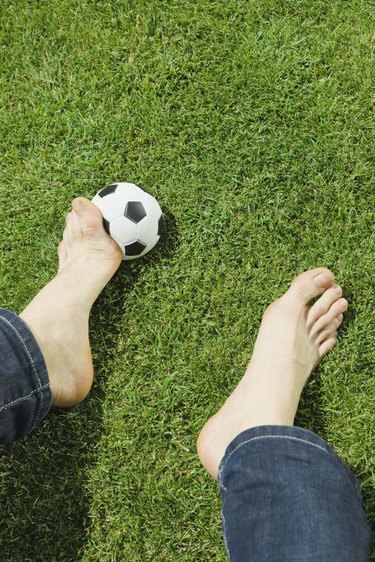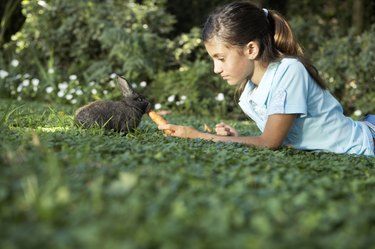 Few grasses are shade tolerant and luxurious. Image Credit: Jupiterimages/Polka Dot/Getty Images
Few grasses are shade tolerant and luxurious. Image Credit: Jupiterimages/Polka Dot/Getty Images
Certain truisms exist in hot, humid Texas and one is that trees in a landscape will eventually shade the yard, and if the ground cover is grass, it needs to be shade-tolerant or you'll have bare soil and mud. One popular lawn cover is Saint Augustine grass (Stenotaphrum secundatum), a warm-season, shade grass intolerant of freezing temperatures. Both traditional and organic gardeners need winterizing strategies for Saint Augustine grass, even in Texas.
Saint Augustine Grass
Saint Augustine grass provides a lush, green lawn with wide, coarse blades and is recommended for U.S. Department of Agriculture plant hardiness zones 8 through 10. The grass spreads rapidly by stolons (above-ground runners) to quickly form a luxurious lawn that invites bare feet. It's shade tolerant and easily removed from garden beds; impenetrable edging prevents stolons from invading gardens. In Texas, it is unreliable north of Fort Worth or Dallas.
Year-Round Care
Healthy lawns, fortunately, require minimal winterizing. Higher mowing heights help prevent germination of sun-craving weed seeds. Recommended heights for shaded grass are 3 inches and should be increased 1/2 inch in the fall or during September and October. Grass accumulates energy for winter dormancy and spring growth during the autumn, resulting in higher and denser blades. Unfortunately, St. Augustine has minimal tolerance for drought conditions and requires additional water, especially in full sun.
Mowing Heights
Numerous theories exist about the height and mowing frequency for St. Augustine grass. Generally, when summer temperatures are hot and the lawn is in full sun, higher heights shade the stolons and reduce water needs. A 2 ½-inch mowing height requires a seven- to 10-day mowing schedule; if mowing at above 2 ½ inches, the intervals can be extended to 10 to 14 days. Thin layers of organic compost in added in the spring improve the grasses vigor.
Winter Weeds
 Not everyone considers weeds in the lawn undesirable. Image Credit: Maria Teijeiro/Digital Vision/Getty Images
Not everyone considers weeds in the lawn undesirable. Image Credit: Maria Teijeiro/Digital Vision/Getty Images
Preemergent herbicides to control cool-season winter annual weed seeds should be applied when the average soil temperature drops to less than 70 degrees Fahrenheit. Preemergent herbicides only prevent seeds from germinating and do not kill existing weeds. Thick, healthy Saint Augustine lawns rarely need preemergence treatment. Organic gardeners should consider corn gluten, a popular preemergent treatment to prevent clover and other cool-season weeds.
Water
Green and growing Saint Augustine grass indicates it is still active and producing energy. When it turns brown in late fall, the grass has gone dormant. Continue to water with a regular schedule of an average of 1 inch of water per week. Warm, windy, winter days are not uncommon and dry the grass; if it shows signs of wilt or if a freeze threatens, water to protect the grass.
Fertilize
Doug Welsh, Texas A & M professor and extension horticulturist, recommends in his book, "Texas Garden Almanac," to wait to apply fertilizer until after this warm-season grass quits growing — usually in October. If you haven't had to mow for two weeks in the fall, the grass has quit growing. His recommendations include using a fertilizer with a 2-1-2 or 1-0-1 ratio with the nitrogen portion a combination of quick and slow forms, applied at a rate of 1 pound per 1,000 square feet.


